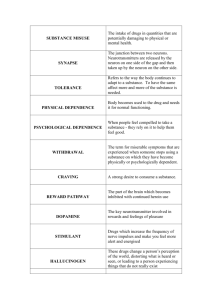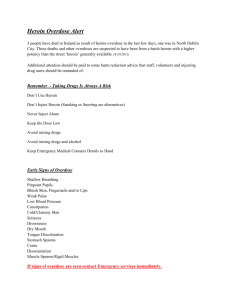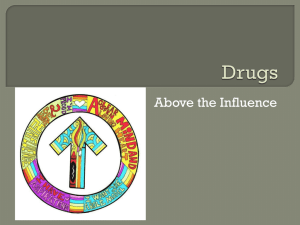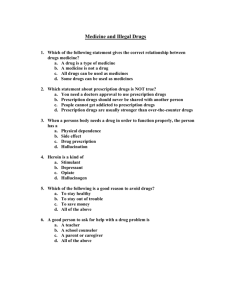What do you know about Drugs
advertisement
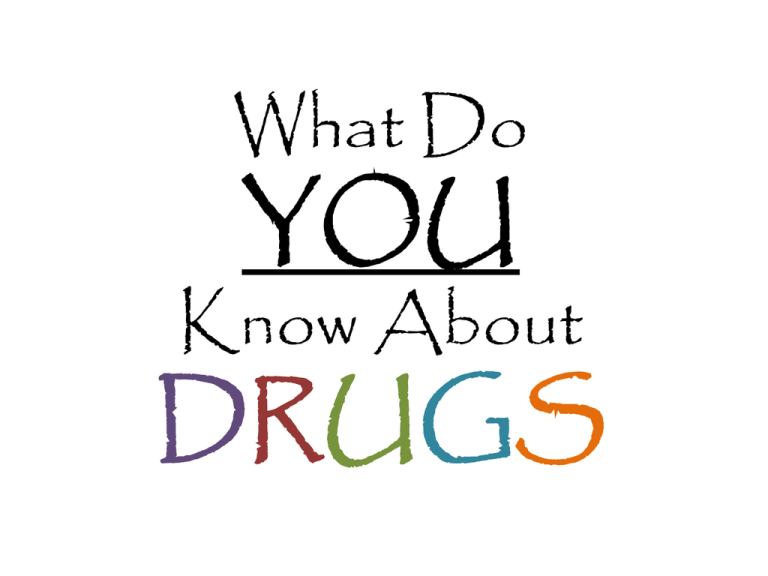
What Do YOU Know About DRUGS Methamphetamine What is Meth? •An abbreviation for methamphetamine •A drug that stimulates the central nervous system •Causing it to release more dopamine, a neurotransmitter that gives someone a feeling of satisfaction. How is meth abused? •Methamphetamine is a white, odorless, bittertasting crystalline powder •It easily dissolves in water or alcohol •Is taken orally, intranasally (snorting the powder), by needle injection, or by smoking. How does Meth affect the brain? •Methamphetamine increases the release and blocks the reuptake of the brain chemical (or neurotransmitter) dopamine, leading to high levels of the chemical in the brain. •Dopamine is involved in reward, motivation, the experience of pleasure, and motor function. • Methamphetamine’s ability to release dopamine rapidly in reward regions of the brain • It produces the intense euphoria, or “rush,” that many users feel after snorting, smoking, or injecting the drug. NOT EVEN ONCE. Cocaine What is Coke? • Cocaine is a naturally derived CNS (central nervous system) stimulant extracted and refined from the Coca plant grown primarily in the Andean region of South America. • Cocaine is typically a white-ish powder with a bitter, numbing taste. How is Coke abused? • Coke in hydrochloride salt form may be injected; swallowed; applied to oral, vaginal, or even rectal mucous membranes; or mixed with liquor. • Coke is most commonly used by snorting or sniffing. How does Coke affect the Brain? • Cocaine attaches to the same transporter binding sites as dopamine. • This means that, when cocaine is introduced, dopamine cannot bind to the dopamine transporter and is stranded in the synapses. • Thus, cocaine's blocking action leads to an increase of dopamine levels in the synapses that, scientists believe, normally produce feelings of pleasure. Ecstasy What is X? • Ecstasy is a synthetic, hallucinogenic drug. • It goes by a number of names including E, X and MDMA. • Ecstasy is in the amphetamine family and is commonly used as a party drug. • In the US, ecstasy is a Schedule I drug, meaning that it has no current acceptable medical use in the United States. • It was given that ranking in 1998. • MDMA was introduced in the USA in the 60s and was legally widely used to treat various psychiatric disorders. • However, rather than cure any disorder, it made most patients worse and its use as a therapeutic agent was abandoned soon after. • The drug became widely known for its psychedelic effects in the 1980s and its use for this purpose has increased over the past 3 decades. • Today, it is the number one Club Drug abused among college students. How is X Abused? • Ecstasy is usually taken by mouth in a pill, tablet, or capsule. • These pills come in different colors and sizes. • They are sometimes inserted into the anus (known as "shafting" or "shelving"). • Injecting ecstasy has increased in recent years. • A typical dose has an onset of about 20 to 60 minutes. • Users feel a euphoric effect that will last about 3 to 5 hours but the effects may last for up to 1-2 days. How does X affect the brain? • X affects the brain by increasing the activity of at least three neurotransmitters: serotonin, dopamine, and norepinephrine. • Like amphetamines, X causes these neurotransmitters to be released from their storage sites in neurons resulting in increased neurotransmitter activity. Heroin What is Heroin? • Heroin is a highly addictive and rapidly acting opiate (a drug that is derived from opium). • Specifically, heroin is produced from morphine, which is a principal component of opium. • Opium is a naturally occurring substance that is extracted from the seedpod of the opium poppy. How is Heroin abused? • Heroin can be injected, snorted/sniffed, or smoked—routes of administration that rapidly deliver the drug to the brain. • Injecting is the use of a needle to administer the drug directly into the bloodstream. • Snorting is the process of inhaling heroin powder through the nose, where it is absorbed into the bloodstream through the nasal tissues. • Smoking involves inhaling heroin smoke into the lungs. • All three methods of administering heroin can lead to addiction and other severe health problems. How does Heroin affect the brain? • Heroin enters the brain, where it is converted to morphine and binds to receptors known as opioid receptors. • These receptors are located in many areas of the brain (and in the body), especially those involved in the perception of pain and in reward. • Opioid receptors are also located in the brain stem—important for automatic processes critical for life, such as breathing (respiration), blood pressure, and arousal. • Heroin overdoses frequently involve a suppression of respiration. Prescription Drugs What is Prescription Drug Abuse? • Prescription drug abuse is when someone takes a medication that was prescribed for someone else or takes their own prescription in a manner or dosage other than what was prescribed. • Abuse can include taking Opioids (such as the pain relievers OxyContin and Vicodin), central nervous system depressants (e.g., Xanax, Valium), and stimulants (e.g., Concerta, Adderall) are the most commonly abused prescription drugs. How are Prescription Drugs abused? • It depends—some people take other people’s drugs for their intended purposes (to relieve pain, to stay awake, or to fall asleep). • Others take them to get high, often at larger doses than prescribed, or by a different route of administration. • Most prescription drugs come in pill or capsule form. • Sometimes, drug users break or crush the pill or capsule, then swallow the drug, sniff it, or “cook” it—turn it to liquid—and then inject it. What’s wrong with abusing Prescription Drugs? • Virtually every medication presents some risk of undesirable side effects, sometimes even serious ones. • Doctors consider the potential benefits and risks to each patient before prescribing medications. • They understand that drugs affect the body in many ways and take into account things like the drug’s form and dose, its possible side effects, and the potential for addiction or withdrawal. • For example, doctors know how to change the dose of a painkiller to prevent withdrawal symptoms. • People who abuse drugs might not understand how these factors may affect them or that prescription drugs do more than cause a high, help them stay awake, help them relax, or relieve pain.



